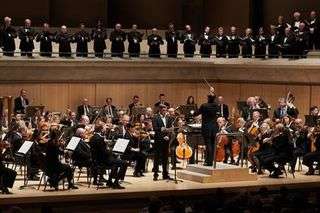|
Back
Gallantry and defiance Toronto
Roy Thomson Hall
05/13/2016 - & May 15, 2016
Wolfgang Amadeus Mozart: Violin Concerto No. 5 in A Major, K. 219
Dmitri Shostakovich: Symphony No. 13 in B-flat Minor, Op. 113
Julian Rachlin (violin), Petr Migunov (bass)
Men of the Amadeus Choir and Elmer Iseler Singers, Lydia Adams (artistic director), The Toronto Symphony Orchestra, Andrey Boreyko (conductor)

P. Migunov & Orchestra (© Malcolm Cook)
Here was a concert of two very contrasting halves - and the near-capacity audience was enthusiastic about both.
Julian Rachlin’s approach to Mozart’s Violin Concerto No. 5 was everything one could want. It was exuberant, sensuous and gentlemanly. His tone is ample, warm, and malleable. He uses it discreetly in understated sections that then give way for more intense sonic expressiveness. It was superbly all of a piece along with Andrey Boreyko’s conducting of the 34-member orchestra.
What a change in the second half, with the hour-long Symphony No. 13, for large orchestra, baritone and male chorus, one of Dmitri Shostakovich’s most anguish-permeated works. Its nickname Babi Yar refers to the poem set in the first of its five movements. A more suitable name for the work would be Soviet Union 1962 as Yevgeny Yevtushenko’s poems reflect a broad range of concerns, many of which apply today, not only in the ex-Soviet countries.
The opening poem refers not only to the slaughter of (mostly) Jewish captives by the invading Germans outside Kiev (now Kyiv) in 1941, but the biased slant that soviet officials put on it, minimizing the Jewish aspect of the atrocity. Yevtushenko’s sardonic poem lacerates bigotry while Shostakovich’s tortured score amplifies the message.
Because of official pressure the text of the poem was changed soon after the work’s premiere. As is now customary, this performance used Yevtushenko’s original words.
The setting of the second poem, “Humour”, provides the work’s scherzo. The orchestral part becomes savagely grotesque; humour obviously has a manic edge in the face of relentless persecution. The third poem, “At the Store” is a paean to the beleaguered, enduring Russian woman; it becomes the adagio movement. The poem becomes sentimental but the punchy chorus and orchestration give it a more epic edge.
If the third poem is the adagio movement, the fourth “Fears” (the one poem written specifically for the symphony) subsides to a level even more solemn, a place too serious for irony. The poet acknowledge the post-Stalinist thaw, but sees new fears arising. Shostakovich’s music seems to be stifled, choked.
The final movement, “A Career” offers reason for hope, as the young poet (just 24 when he wrote the poem) vows to emulate Galileo, a teller of truth in the face of tyranny. There is jauntiness (with an ironic tinge) and defiance. The ending is surprisingly gentle, with mingled chimes - a serene hopefulness after the earlier tumult.
The gentlemen from Lydia’ Adams’s two choruses acquitted themselves well. One assumes a Russian choir is de rigueur in such a work, but they are adept at a wide range of repertoire, including this.
I am sure it isn’t necessary to have a conductor and soloist who are both from St. Petersburg, the city we connect so closely to the composer, but in this case it seems to help. Andrey Boreyko is part way through recording all 15 Shostakovich symphonies. He hasn’t yet recorded the 13th but it is bound to be a winner, especially with Petr Migunov as soloist. His attractive bass voice handles all aspects of the expressive score with apparent ease.
The single flaw in the presentation was in the printed program where the Russian text was printed in the Cyrillic alphabet instead of being transliterated into the Roman alphabet. We then would have been able to follow the interchanges between the soloist and chorus.
The TSO has embarked on a decade-by-decade overview of 20th century music. This will be accomplished over five seasons, with the 1960s covered in the fall of 2018. The Babi Yar symphony certainly deserves to stand as one of the key works of its era.
Michael Johnson
|